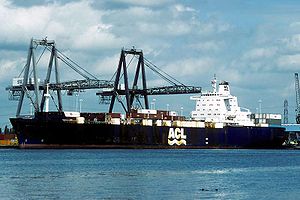Atlantic Causeway

| |
| Career | |
|---|---|
| Name: | MV Atlantic Causeway |
| Operator: | Cunard Line |
| Builder: | Swan Hunter |
| Completed: | 1969 |
| Fate: | Scrapped in 1986 |
| General characteristics | |
| Class and type: | Container ship |
| Tonnage: | 14,946 tons |
| Speed: | 22 knots |
The Atlantic Causeway was a container ship, operated by Cunard, and one of the merchant vessels requisitioned by the British government to support British forces in the Falklands War in 1982.
Contents
Pre-war
The Atlantic Causeway and her sister, Atlantic Conveyor were built by Swan Hunter as part of Cunard's contribution to Atlantic Container Lines, a European shipping consortium. The Atlantic Causeway was completed in 1969. With the outbreak of the Falklands War the Atlantic Conveyor was requisitioned on 14 April, and the Atlantic Causeway on 4 May to serve as transport and support ships for the Royal Navy taskforce being sent to retake the Falkland Islands.
Falklands War
Atlantic Causeway put into HMNB Devonport and was taken in hand on 6 May. She was converted to be able to carry and operate helicopters, and was also fitted with a ski jump to enable her to operate Sea Harriers.[1] A hangar was fitted to her upper deck, and an improved system for delivering aviation fuel. She sailed from Devonport on 14 May carrying eight Sea King HAS.2As of 825 Naval Air Squadron and twenty Wessex HU.5s of 847 Naval Air Squadron.[2] She sailed to the Exclusion Zone via Ascension Island, arriving on 27 May, two days after her sister, Atlantic Conveyor had been hit and burnt out by Exocet missiles.[3] She then disembarked her aircraft and stores in San Carlos Water from 30 May, remaining on station with the rest of the British fleet.[4] She took on casualties from the Royal Fleet Auxiliary ships RFA Sir Galahad and Sir Tristram after they were hit by Argentinian bombs and abandoned on 8 and 9 June. Around 170 of those transferred were later returned to Britain aboard the tankers British Trent and British Test. Atlantic Causeway entered Port William on 17 June to unload further supplies, before leaving to return to Britain on 13 July.[5] She had received around 4,000 helicopter landings and refuelled about 500 aircraft.[6]
Postwar
Atlantic Causeway was laid up in Liverpool, finally being broken up in Taiwan in 1986.[1] Detailed plans of both the Atlantic Causeway and the Atlantic Conveyor are held by The National Archives.[7]
Notes
- ↑ 1.0 1.1 Access to Archives (A2A) catalogue description, The National Archives, for records held by Tyne and Wear Archives Service, transferred from Swan Hunter. Retrieved 2008-07-17.
- ↑ Week Seven of the Falklands War
- ↑ British Task Force Movements, 24th-30 May 1982
- ↑ Falkland Area Operations, 31 May-6 June 1982
- ↑ MAIN BRITISH TASK FORCE RETURNS HOME
- ↑ Data on the Atlantic Causeway, South Atlantic Medal Association website. Retrieved 2008-07-17
- ↑ Hierarchical catalogue view for MT 146, The National Archives, overview of plans and documents from the Ministry of Transport, Marine Division. Retrieved 2008-07-17
References
- BATTLE ATLAS of the FALKLANDS WAR 1982 - by Land, Sea and Air, Gordon Smith. Retrieved 2008-07-17.
- Falkland Islands order of battle, RAF website, 2004. Retrieved 2008-07-17
- Ships of the Falklands War, Chris Valentine. Retrieved 2008-07-17
